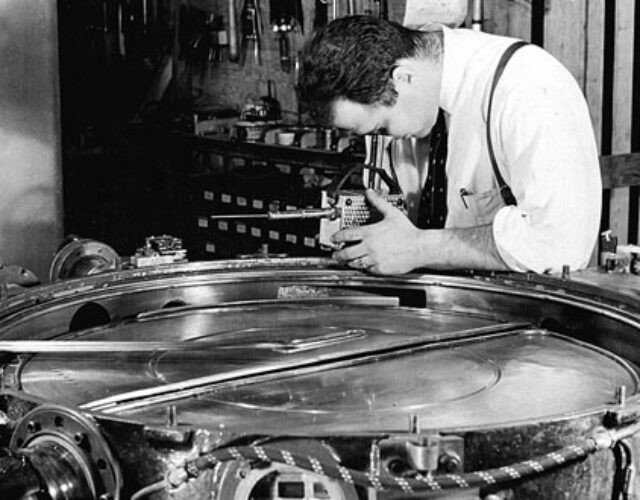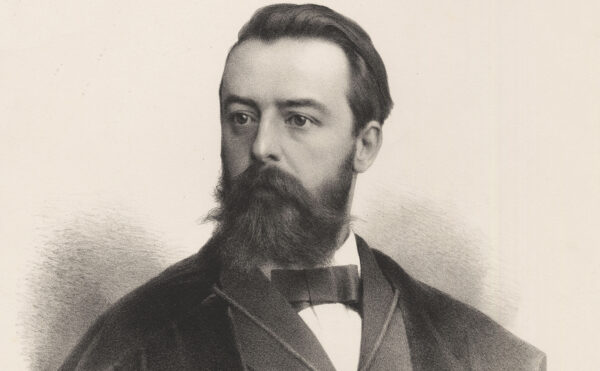In a cluttered lab at Harvard University, scientists built machines that conjured forces of destruction and salvation.
In 1970 Harvard University’s proton accelerator was the latest weapon against inoperable and hard-to-reach cancers. Even its official name—cyclotron—sounded like a device from Star Trek.
In fact, cyclotrons were practically antique. Physicist Ernest Lawrence had built the first one at the University of California, Berkeley, in 1931, sparking three decades of groundbreaking atomic research. Harvard’s cyclotron laboratory was built a few years later, but as research advanced it went from cutting-edge to ubiquitous to obsolete—until oncologists from Massachusetts General Hospital saved the lab’s antique accelerator from the scrapyard.
Long before its first patient was cured, Harvard’s cyclotron laboratory played a part in ending one war and starting another. Harvard cyclotrons lived many lives: they were rooted in chemistry, refined for physics, and finally repurposed for medicine. These machines were not only cutting-edge but also double-edged, with the power to create and to destroy.
Harvard’s first cyclotron was completed in 1938. At its core was a magnet the weight of a house—so heavy at 85 tons that it had to be shipped in by railroad car. A cyclotron makes use of the fact that an electric field will speed up the protons passing through it. A hefty magnet can bend the protons in a circle, which pushes them through the accelerating electric field again and again. The protons speed up in the spiral shape of a snail’s shell, until they shoot out of the machine in a precise beam.
In the years before World War II, scientists could do a lot with a speeding beam of protons. For example, they could investigate the nucleus by shooting protons at known elements and studying the unfamiliar results. Putting radiation to use was certainly nothing new. (Soon after Marie Curie discovered radium in 1898 doctors pioneered crude radiation treatments by taping radioactive capsules to their patients’ tumors.) But early researchers got their protons from radioactive elements, which were expensive to mine and dangerous to handle. Particle accelerators gave scientists an unprecedented capacity: the control of radiation without radioactive isotopes mined from the earth.
Then war broke out in Europe, and American science was pulled in radically new directions. By 1940 the United States was pouring money and manpower into military production and research. Fractured departments of physics, chemistry, and engineering became the building blocks of military research groups like the Massachusetts Institute of Technology’s Radar Lab and the Chemical Warfare Service. Many Harvard scientists joined the effort.
The cyclotron would follow some of them to the most famous research site created during the war: Los Alamos. In 1943 a U.S. Army Medical Corps radiologist arrived at Harvard. His orders were to purchase the cyclotron for the government, ostensibly to create isotopes for leukemia treatment and medical diagnosis.
Many of Harvard’s physicists suspected that medicine was only a front. They knew a powerful magnet could not only accelerate protons but would work on any charged particle. Heavier particles make a larger spiral, the way heavier cars make wider turns around a corner. And in 1943 there was one particular, and confidential, application for separating heavy and light particles. The isotope uranium-235, unlike its heavier cousin uranium-238, can sustain a nuclear chain reaction. Cyclotrons could be used to enrich nuclear fuel.
Harvard’s proton accelerator was probably not used to separate out uranium-235, though comparable cyclotrons from other American labs were. But cyclotrons are versatile machines, and the device from Harvard found a related use. Scientists could generate a fast-moving neutron by shooting an accelerated proton at a beryllium sheet, which absorbed the proton and released a neutron. This neutron shot away from the beryllium like a subatomic billiard ball. If it then struck enriched uranium, the neutron could set off a chain reaction, acting almost like a nuclear fuse. Harvard’s cyclotron enabled scientists to fine-tune this method of detonation, an essential component in creating the first nuclear weapons.
One of those weapons exploded over Hiroshima in August 1945. More than 100,000 people died from the effects of the bomb. Barely a week later, after the United States detonated a plutonium-fueled bomb above Nagasaki, the war was over. Hundreds of thousands of soldiers returned home from the Pacific, while thousands of military scientists returned to their home universities. Their knowledge of physics and chemistry had taken on a new and stunning reality in Japan.
One returning scientist was the physicist Robert Wilson. He and his colleagues returned to Harvard’s empty cyclotron lab and immediately began planning a second expanded cyclotron that would reestablish their research. Like many of his peers, Wilson was disillusioned by the destruction unleashed by wartime science. In 1946 he wrote a short paper for the American Journal of Radiology. He considered this paper a kind of atonement for helping develop the nuclear bomb.
Small proton accelerators had been too weak to interest radiologists, Wilson wrote. But the next-generation cyclotron—Harvard’s new 160-ton machine, for instance—would be powerful enough to shoot protons deep into human tissue. “The particles themselves now become of considerable therapeutic interest,” the paper emphasized. Though Wilson left Harvard soon afterward, he had provided the foundational insight that protons could feasibly fight cancer.
It was therefore mostly Wilson’s fault that Harvard’s cyclotron laboratory started smelling like monkeys. In the late 1950s, between experiments on atomic particles, a doctor-physicist team started testing “fast protons” on primate tumors. Over the next decade the Harvard cyclotron’s usefulness for physics research dwindled. The lab’s veteran physicists even threw a party celebrating the imminent retirement of their long-lived machine.
Their celebration was premature. The primate research, along with experiments from several international labs, showed that the Harvard cyclotron accelerated protons to half the speed of light—fast enough to penetrate 17 centimeters into human flesh. Deep inside a tumor positively charged protons can strip negatively charged electrons from a cancerous cell’s DNA. Repeated doses can disrupt the replication of many cancers. The accuracy of proton beams meanwhile allowed doctors to use relatively high doses at lower risk to noncancerous tissue.
In the mid-1960s doctors began using the Harvard cyclotron to treat tumors in humans. They were using the same basic principle as the first radiologists in the early 1900s. The crucial difference was that doctors could now aim and adjust their radiation beam. For an oncologist treating complicated cancers—for example, tumors located in the eye or spine—the cyclotron proved as nimble as any scalpel. And this was why to patients and even to some doctors proton therapy still seemed like science fiction.
Only after 9,000 cancer patients had been treated did the cyclotron finally shut down for good, in 2002. (An even larger medical cyclotron succeeded it at Massachusetts General Hospital.) The control console of Harvard’s retired cyclotron, now displayed at the Harvard Collection of Historical Scientific Instruments, is an eclectic testament to its versatility. It includes not only modern computer components but also meters and gauges dating to the 1950s—a 50-year span folded into a single machine.




